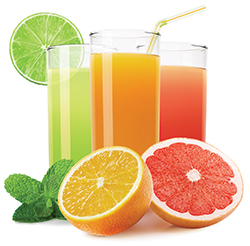An increasing number of foodservice operations now take advantage of freshly squeezed juice on its own or as part of a breakfast, specialty beverage, cocktail or smoothie program due to the potentially high profit margins offered by these on-trend products. For this reason, commercial juicers are becoming more commonplace not only in quick- and casual-service restaurants but also in higher-end establishments with upscale bar menus. Operators can choose from various commercial juicing equipment, depending on their needs.
 Citrus squeezers are intended for lemons, limes, oranges and similar fruits. These manual units provide low- and high-volume production. The most basic is a citrus reamer, where the user places the cut side of the fruit over the unit and manually pushes down and twists. This is best for smaller volumes as this process can be labor intensive, time-consuming and messy. Citrus squeezers are recommended for small restaurants and bars that require fresh juice for cocktails or juice beverages. These units have long handles for easier use and better leverage and a small squeezer for extracting juice in small quantities.
Citrus squeezers are intended for lemons, limes, oranges and similar fruits. These manual units provide low- and high-volume production. The most basic is a citrus reamer, where the user places the cut side of the fruit over the unit and manually pushes down and twists. This is best for smaller volumes as this process can be labor intensive, time-consuming and messy. Citrus squeezers are recommended for small restaurants and bars that require fresh juice for cocktails or juice beverages. These units have long handles for easier use and better leverage and a small squeezer for extracting juice in small quantities.
A more comprehensive manual juicer, the juice press, is an upright unit with a metal base. To juice, cut fruit is put on an integral reamer and a lever is pulled downward. This prompts the squeezer to press the fruit and extract its juice into a container underneath the unit. An electric reamer machine is similar to a manual reamer but utilizes an electric motor to twist the fruit. These are simple to use but still require manual labor during the process. This type is appropriate for operations with medium to high juice volumes.
Centrifugal juicers grate and then spin fruit or vegetables quickly against a sieve using centrifugal force for extraction. The meat of the product is pushed to one side and the juice to the other through a screen for pulp and seed straining. Some types are equipped with large, continuous feed chutes so whole fruits and vegetables can be fed into the machine, eliminating the need to cut product into smaller sizes. This is the fastest method, producing between 120 and 160 quarts of juice per hour, so it is best utilized for high-volume production. It also can handle dense products, like apples, as well as a wide range of vegetables. However, due to the air created during the process, this juicer type may compromise the end product’s shelf life. Other drawbacks are the consistency, which tends to be foamier due to the speed of the unit, and the resulting oxidation, which eliminates some nutrients in the concoction. This type also isn’t recommended for leafy greens as it tends to not extract as much juice as other methods.
Masticating juicers, also called single-gear or single-auger juicers, use a gear or auger to separate produce’s juice from its pulp. Because this process breaks up the plant cells, more fiber, enzymes, vitamins and minerals are released into the juice. This efficient type extracts the most juice from product, although it works slower than centrifugal juicers to do the same job. The benefit of this is less froth or foam, a higher nutrient content due to less heat being produced and a longer shelf life for the end product. While food being fed into these machines needs to be cut smaller for processing, they can handle juicing leafy greens, such as wheatgrass, spinach and lettuce.
There also are upright masticating juicers, which are newer and provide high yields at a low speed in a smaller footprint than standard single-auger units. These can work with a variety of produce and extract large amounts of juice while ejecting pulp.
Twin-gear or triturating juicers extract liquid by pressing produce between two interlocking roller gears, creating pressure on the food. Operating at slow RPMs, these units create less foam and oxidation for a longer juice shelf life and also retain nutrients lost during the heat of faster juicing methods. Like masticating types, these juicers extract high yields from a wide variety of produce and can handle leafy greens.
Filters on these units have been reengineered to properly screen out pulp and seeds. Automatic pulp sweepers are available on some models that help decrease labor, but these also tend to reduce product yield.



